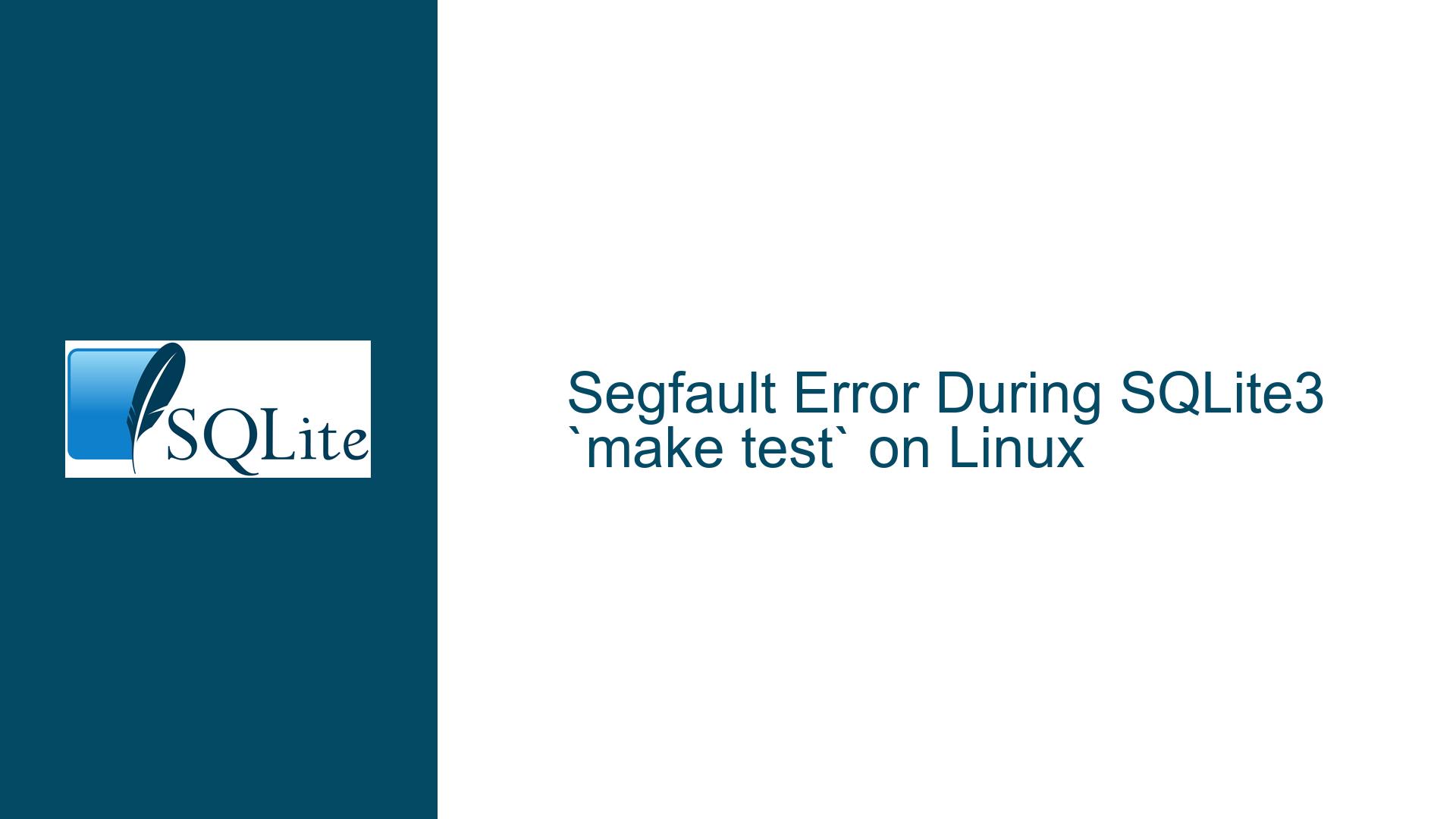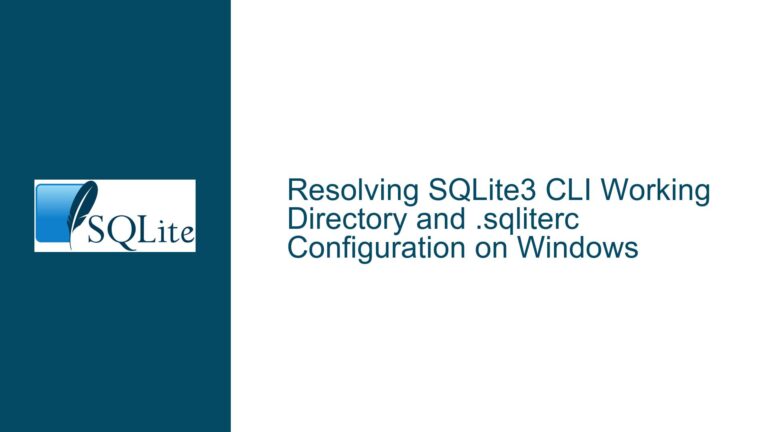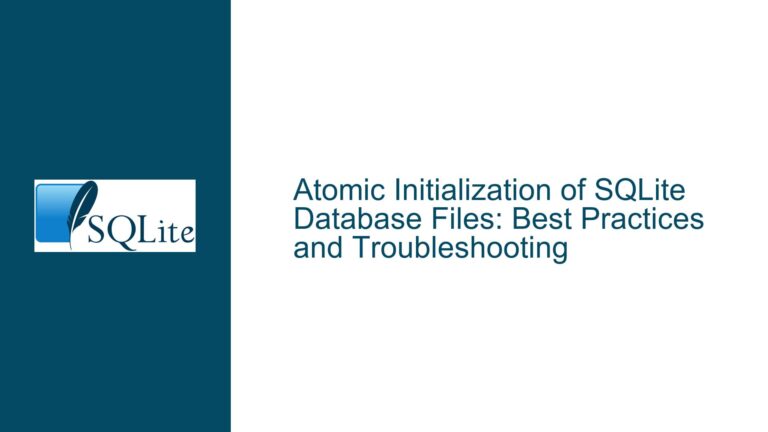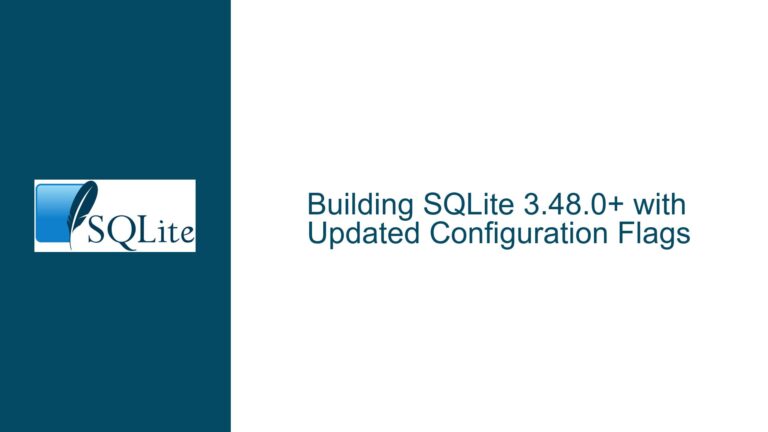Segfault Error During SQLite3 `make test` on Linux
Issue Overview: Segfault During SQLite3 Test Execution
When compiling SQLite3 from source on a Linux system, a segmentation fault (segfault) occurs during the execution of the make test command. The specific error message indicates that the fuzzcheck utility crashes when attempting to process the fuzzdata1.db database file. The segfault is a critical error that typically arises when a program attempts to access a memory location that it is not permitted to access, or when it attempts to access a memory location in a way that is not allowed (e.g., writing to a read-only location). This issue is particularly problematic because it prevents the successful completion of the SQLite3 test suite, which is essential for verifying the integrity and correctness of the compiled SQLite3 library.
The segfault occurs at a specific point in the testing process, namely when the fuzzcheck utility is invoked with the fuzzdata1.db file as an argument. The fuzzcheck utility is part of SQLite’s fuzz testing framework, which is designed to test the robustness of the SQLite library by subjecting it to a wide range of potentially malformed or unexpected inputs. The fact that the segfault occurs during this phase of testing suggests that there may be an issue with the way the fuzzcheck utility is interacting with the fuzzdata1.db file, or that there may be a problem with the fuzzdata1.db file itself.
Possible Causes: Memory Corruption, Database Corruption, or Compilation Issues
The segfault error during the execution of make test can be attributed to several potential causes, each of which requires careful investigation. The primary suspects include memory corruption, database file corruption, and issues related to the compilation process.
Memory Corruption: Memory corruption is a common cause of segfaults and can occur when a program writes data beyond the bounds of an allocated memory block, or when it attempts to access memory that has already been freed. In the context of the fuzzcheck utility, memory corruption could be caused by a bug in the SQLite library that is exposed when the utility processes the fuzzdata1.db file. This could be due to an uninitialized variable, a buffer overflow, or a use-after-free error. Memory corruption can be particularly difficult to diagnose because the symptoms may not manifest immediately, and the root cause may be located in a different part of the code than where the crash occurs.
Database File Corruption: Another possible cause of the segfault is corruption in the fuzzdata1.db file itself. The fuzzcheck utility is designed to handle malformed or unexpected inputs, but if the database file is severely corrupted, it may cause the utility to crash. Database file corruption can occur due to a variety of reasons, including disk errors, bugs in the SQLite library, or issues with the tools used to generate the fuzzdata1.db file. If the fuzzdata1.db file is corrupted, it may contain invalid data structures or references to memory locations that do not exist, leading to a segfault when the fuzzcheck utility attempts to process the file.
Compilation Issues: The segfault could also be caused by issues related to the compilation of the SQLite3 source code. If the source code was not compiled correctly, or if there were errors during the compilation process, the resulting binary may contain bugs or inconsistencies that lead to a segfault. Compilation issues can arise due to a variety of factors, including incorrect compiler flags, missing dependencies, or incompatibilities between the compiler and the source code. Additionally, if the fuzzcheck utility was not compiled correctly, it may not be able to properly handle the fuzzdata1.db file, leading to a crash.
Troubleshooting Steps, Solutions & Fixes: Debugging and Resolving the Segfault
To diagnose and resolve the segfault error during the execution of make test, a systematic approach is required. The following steps outline a comprehensive troubleshooting process that includes using a debugger to identify the root cause of the crash, verifying the integrity of the fuzzdata1.db file, and ensuring that the SQLite3 source code was compiled correctly.
Step 1: Using a Debugger to Identify the Root Cause
The first step in troubleshooting the segfault is to use a debugger to identify the exact location in the code where the crash occurs. The GNU Debugger (GDB) is a powerful tool that can be used to debug C and C++ programs, including the fuzzcheck utility. To use GDB, follow these steps:
Invoke GDB with the
fuzzcheckUtility: After the segfault occurs, invoke GDB with thefuzzcheckutility and thefuzzdata1.dbfile as arguments. This can be done by running the following command in the terminal:gdb --args ./fuzzcheck /home/haris/sqlite/test/fuzzdata1.dbRun the Program in GDB: Once GDB is running, type the
runcommand to execute thefuzzcheckutility within the debugger. If the program crashes, GDB will halt execution and provide information about the crash.Obtain a Stack Trace: After the crash, type the
where fullcommand in GDB to obtain a full stack trace. The stack trace will show the sequence of function calls that led to the crash, along with the values of the local variables at each level of the stack. This information is crucial for identifying the root cause of the segfault.Interpret the Stack Trace: Analyze the stack trace to determine the exact location in the code where the crash occurred. Look for any suspicious function calls or variable values that may indicate memory corruption or other issues. If the stack trace points to a specific line of code in the SQLite library, examine that code to identify any potential bugs or vulnerabilities.
Step 2: Verifying the Integrity of the fuzzdata1.db File
If the debugger does not reveal any obvious issues in the code, the next step is to verify the integrity of the fuzzdata1.db file. A corrupted database file could be the cause of the segfault, so it is important to ensure that the file is not damaged.
Check the File Size and Contents: Begin by checking the size and contents of the
fuzzdata1.dbfile. A database file that is unusually small or large may indicate corruption. Use thels -lcommand to check the file size, and thefilecommand to verify that the file is a valid SQLite database.Run SQLite’s Integrity Check: SQLite provides a built-in integrity check that can be used to verify the consistency of a database file. To run the integrity check, open the
fuzzdata1.dbfile using the SQLite command-line interface and execute thePRAGMA integrity_check;command. If the database file is corrupted, the integrity check will report any inconsistencies or errors.Regenerate the
fuzzdata1.dbFile: If the integrity check reveals that thefuzzdata1.dbfile is corrupted, it may be necessary to regenerate the file. Thefuzzdata1.dbfile is typically generated as part of the SQLite test suite, so re-running the test suite may create a new, uncorrupted version of the file. Alternatively, if the file was generated manually, ensure that the correct tools and procedures were used to create it.
Step 3: Ensuring Correct Compilation of the SQLite3 Source Code
If the fuzzdata1.db file is not corrupted, the next step is to ensure that the SQLite3 source code was compiled correctly. Compilation issues can lead to bugs or inconsistencies in the resulting binary, which may cause the fuzzcheck utility to crash.
Verify Compiler Flags: Ensure that the correct compiler flags were used during the compilation process. SQLite provides a set of recommended compiler flags that should be used to optimize the performance and stability of the library. These flags can be found in the SQLite documentation. If the recommended flags were not used, recompile the source code with the correct flags.
Check for Missing Dependencies: Ensure that all required dependencies were installed before compiling the SQLite3 source code. Missing dependencies can lead to compilation errors or runtime issues. Use the
lddcommand to check for missing shared libraries in the compiled binary.Recompile the Source Code: If there were any issues during the initial compilation, recompile the SQLite3 source code from scratch. Begin by cleaning the build directory to remove any previously compiled objects, then run the
./configure,make, andmake sqlite3.ccommands again. After recompiling, run themake testcommand to see if the segfault error persists.
Step 4: Analyzing the SQLite Source Code for Potential Bugs
If the above steps do not resolve the segfault, it may be necessary to analyze the SQLite source code for potential bugs. The fuzzcheck utility is part of SQLite’s fuzz testing framework, which is designed to test the robustness of the library by subjecting it to a wide range of inputs. If the segfault occurs during fuzz testing, it may indicate a bug in the SQLite library that is exposed by the fuzzdata1.db file.
Review the Code Around the Crash Location: Examine the code around the location where the crash occurs, as identified by the debugger. Look for any potential issues, such as uninitialized variables, buffer overflows, or use-after-free errors. Pay particular attention to any code that interacts with the
fuzzdata1.dbfile or processes its contents.Check for Known Issues: Review the SQLite issue tracker and mailing lists for any known issues that may be related to the segfault. If the issue has been reported before, there may be a patch or workaround available. If the issue is new, consider reporting it to the SQLite development team.
Apply Patches or Fixes: If a patch or fix is available for the issue, apply it to the SQLite source code and recompile the library. After applying the patch, run the
make testcommand again to see if the segfault error is resolved.
Step 5: Testing on a Different System or Environment
If the segfault persists after following the above steps, it may be helpful to test the SQLite3 source code on a different system or environment. This can help determine whether the issue is specific to the current system or environment, or whether it is a more general problem with the SQLite library.
Test on a Different Linux Distribution: If the segfault occurs on a specific Linux distribution, try compiling and testing the SQLite3 source code on a different distribution. This can help identify any distribution-specific issues that may be causing the crash.
Test on a Different Architecture: If possible, test the SQLite3 source code on a different architecture, such as x86_64 or ARM. This can help identify any architecture-specific issues that may be causing the segfault.
Test with a Different Compiler: If the segfault occurs with a specific compiler, try compiling the SQLite3 source code with a different compiler. For example, if the issue occurs with GCC, try compiling with Clang. This can help identify any compiler-specific issues that may be causing the crash.
Step 6: Reporting the Issue to the SQLite Development Team
If all else fails, and the segfault error persists, it may be necessary to report the issue to the SQLite development team. When reporting the issue, provide as much information as possible, including the steps to reproduce the error, the stack trace from the debugger, and any relevant details about the system and environment. The SQLite development team is highly responsive and may be able to provide additional insights or a fix for the issue.
Gather Relevant Information: Before reporting the issue, gather all relevant information, including the version of SQLite being used, the operating system and architecture, the compiler and compiler flags used, and the exact steps to reproduce the error. Include the stack trace from the debugger and any other diagnostic information that may be helpful.
Submit a Bug Report: Submit a bug report to the SQLite issue tracker or mailing list. Be sure to include all relevant information and follow any guidelines provided by the SQLite development team for reporting issues. Provide a clear and concise description of the problem, and be prepared to answer any follow-up questions from the development team.
Follow Up on the Issue: After submitting the bug report, monitor the issue tracker or mailing list for any updates or responses from the SQLite development team. If additional information or testing is required, be prepared to provide it. Once a fix is available, apply it to the SQLite source code and verify that the segfault error is resolved.
Conclusion
The segfault error during the execution of make test on Linux is a complex issue that can be caused by a variety of factors, including memory corruption, database file corruption, and compilation issues. By following a systematic troubleshooting process, it is possible to identify and resolve the root cause of the crash. Using a debugger to obtain a stack trace, verifying the integrity of the fuzzdata1.db file, ensuring correct compilation of the SQLite3 source code, and analyzing the source code for potential bugs are all essential steps in the troubleshooting process. If the issue persists, testing on a different system or environment and reporting the issue to the SQLite development team may be necessary. With careful investigation and persistence, the segfault error can be resolved, allowing the SQLite3 test suite to complete successfully.






